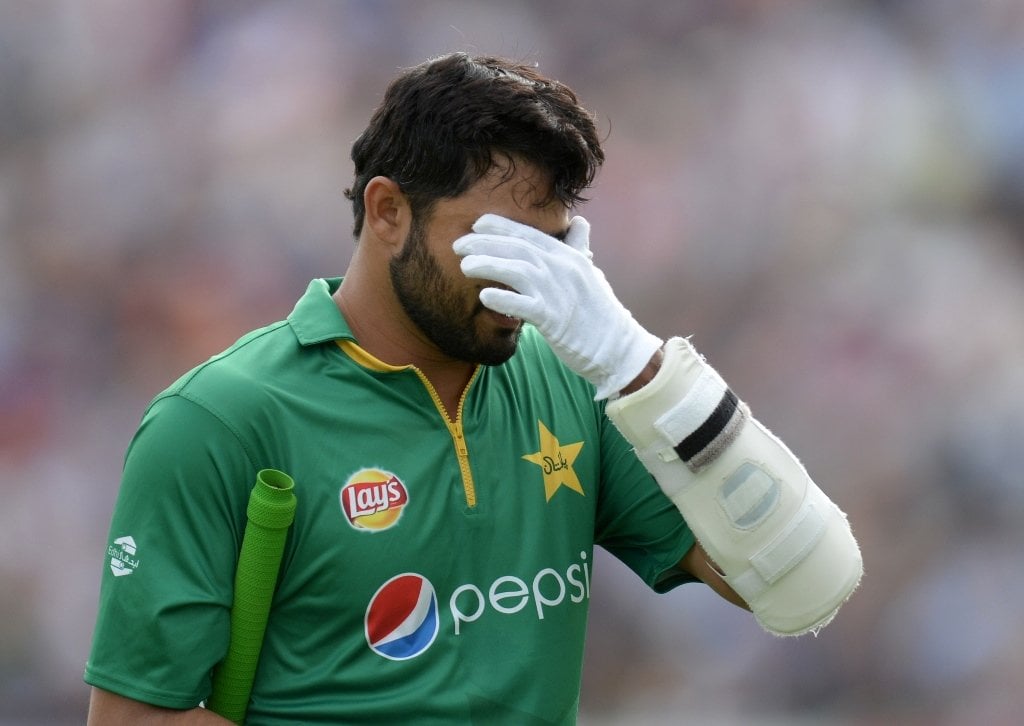
Unpredictable Pakistan are consistently good in the white kit of the five-day game, but miserable in the short forms' coloured clothing, sometimes known as "pyjamas". They have also dropped to seventh in the T20I rankings.
Last month, they climbed to number one Test side for the first time after their 2-2 series draw in England -- before crashing to earth with a 4-1 defeat in the subsequent ODI series.
Pakistan's legendary pace bowler Wasim Akram described the contrast as "inevitable" given the way other teams have transformed their batting.
England, who exited last year's 50-over World Cup at the pool stage, are now a force in ODIs, smashing a world-record 444 in the third match against Pakistan.
Sarfraz credits T20I victory to bowlers, openers
 PHOTO: REUTERS
PHOTO: REUTERS"We did not keep pace with changes in limited-overs cricket," Akram told AFP.
"While other teams progressed in leaps and bounds -- look at England how they have transformed since the 2015 World Cup -- we have slumped.
"We have had a settled squad in Tests so we have produced good results but we didn't have back-ups for Misbahul Haq, Shahid Afridi and Saeed Ajmal in limited-overs cricket."
Afridi and Misbah retired from one-day cricket after last year's World Cup, where Pakistan were hammered by Australia in the quarter-finals.
England fared worse, but they have become a formidable limited-overs outfit under coach Trevor Bayliss, reaching the World T20 final earlier this year.
Pakistan steamroll England in one-off T20I by nine wickets
 ODI skipper Azhar Ali (L) with Amir (R). PHOTO: AFP
ODI skipper Azhar Ali (L) with Amir (R). PHOTO: AFPFormer captain Imran Khan, who led Pakistan to their only 50-over World Cup victory in 1992, said a solution may be for 42-year-old Misbah to make a comeback.
"Why can a player who is so successful in Tests not continue in one-days?" he asked. "If he has made Pakistan number one in Tests he can lift the team in ODIs as well."
Whether's Khan's solution holds merit is debatable. Misbah became Pakistan's Test captain in 2010 and one-day captain a year later.
If he can be credited with Pakistan's success in Tests, then the responsibility for the slump in ODIs must also lie partly on his shoulders.
His tenure got off to a bright start, with the pairing of off-spinner Saeed Ajmal and left-arm quick Junaid Khan responsible for anchoring Pakistan's seven one-day series wins in 2013, including victories in India and South Africa.
 Left-handed opener Sami Aslam. PHOTO: AFP
Left-handed opener Sami Aslam. PHOTO: AFPBut Ajmal lost his wicket-taking mojo when he was forced to remodel his action after it was deemed illegal in 2014. Junaid was sidelined with injury and his form dropped away.
Pakistan's fortunes went into free-fall and they didn't win a single series in 2014.
The trend continued as Pakistan were whitewashed by Bangladesh 3-0 in April 2015 after Azhar Ali replaced Misbah as captain.
In Tests, they unearthed a new match-winner in leg-spinner Yasir Shah, who has been key to series wins over Australia and England at 'home' in the UAE and away in Sri Lanka.
His 10 wickets in the victory at Lord's and five at The Oval helped pave Pakistan's path to Test number one.
Sarfraz to make captaincy bow at Old Trafford
 Pacer Mohammad Amir. PHOTO: AFP
Pacer Mohammad Amir. PHOTO: AFPAkram also blamed continuous changes to the one-day team, with 21 new players in four years.
"You need to persist with players for 10-12 matches and be patient with them, we didn't do that recently," said Akram, pointing towards 34 different opening pairs in the last four years.
The growing sense is that Pakistan's batting is just not up to the explosive standards set by the likes of Australia's David Warner, South Africa's AB de Villiers and India's Virat Kohli.
Pakistan's middle order is anchored around players such as the steady captain Ali and Asad Shafiq who have stepped up in Test cricket but lack the power-hitting needed in the limited-over format.
The dearth of batting talent is apparent on the domestic scene, which produces small totals out-of-step with the modern game.
 All-rounder Imad Wasim. PHOTO: AFP
All-rounder Imad Wasim. PHOTO: AFPThe 11 Pakistan Cup one-day tournament matches held this year produced only six scores of more than 300.
"We have to produce new players," said chief selector Inzamamul Haq. "One-day cricket now requires batsmen who can clear the boundary more often and bowlers who can disguise with variation."
Pakistan are in a race against time. If they do not rise to the top eight in the ODI rankings by the end of September next year, they will have to play qualifying rounds for the 2019 World Cup in England.
The strong sense is that Pakistan are still playing one-day cricket of the 1990s and they need more hitters such as newcomer Sharjeel Khan and wicketkeeper Sarfraz Ahmed to drag them into the 21st century.

















COMMENTS (1)
Comments are moderated and generally will be posted if they are on-topic and not abusive.
For more information, please see our Comments FAQ